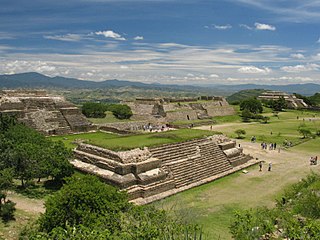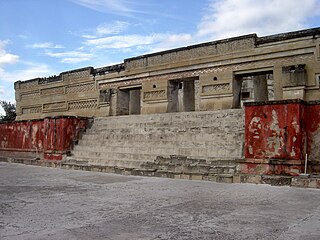Related Research Articles

Oaxaca, officially the Free and Sovereign State of Oaxaca, is one of the 32 states which compose the Federative Entities of Mexico. It is divided into 570 municipalities, of which 418 are governed by the system of usos y costumbres with recognized local forms of self-governance. Its capital city is Oaxaca de Juárez.

The city and municipality of Oaxaca de Juárez, or simply Oaxaca, is the capital and largest city of the eponymous Mexican state. It is located in the Centro District in the Central Valleys region of the state, on the foothills of the Sierra Madre at the base of the Cerro del Fortín extending to the banks of the Atoyac River. The city relies heavily on tourism, which is based on its large number of colonial-era structures as well as the native Zapotec and Mixtec cultures and archeological sites. The city, together with the archeological site of Monte Albán, was named a World Heritage Site in 1987. It is also the home of the month-long cultural festival called the "Guelaguetza", which features Oaxacan dance from the seven regions, music and a beauty pageant for indigenous women.

Mitla is the second most important archeological site in the state of Oaxaca in Mexico, and the most important of the Zapotec culture. The site is located 44 km from the city of Oaxaca. in the upper end of the Tlacolula Valley, one of the three that form the Central Valleys Region of the state. The archeological site is within the modern municipality of San Pablo Villa de Mitla. While Monte Albán was most important as the political center, Mitla was the main religious center. The name Mitla is derived from the Nahuatl name Mictlán, which was the place of the dead or underworld. Its Zapotec name is Lyobaa, which means “place of rest.” The name Mictlán was Hispanicized to Mitla by the Spanish. However, what makes Mitla unique among Mesoamerican sites is the elaborate and intricate mosaic fretwork and geometric designs that cover tombs, panels, friezes and even entire walls. These mosaics are made with small, finely cut and polished stone pieces which have been fitted together without the use of mortar. No other site in Mexico has this.

The Sierra Madre del Sur is a mountain range in southern Mexico, extending 1,000 kilometres (620 mi) from southern Michoacán east through Guerrero, to the Isthmus of Tehuantepec in eastern Oaxaca.

The Zapotec civilization was an indigenous pre-Columbian civilization that flourished in the Valley of Oaxaca in Mesoamerica. Archaeological evidence shows that their culture goes back at least 2,500 years. The Zapotec left archaeological evidence at the ancient city of Monte Albán in the form of buildings, ball courts, magnificent tombs and grave goods including finely worked gold jewelry. Monte Albán was one of the first major cities in Mesoamerica and the center of a Zapotec state that dominated much of the territory that today belongs to the Mexican state of Oaxaca.

The Sierra Madre de Oaxaca pine–oak forests are an ecoregion of the Tropical and subtropical coniferous forests biome, in Southern Mexico.

The Sierra Madre de Oaxaca is a mountain range in southern Mexico. It is primarily in the state of Oaxaca, and extends north into the states of Puebla and Veracruz.
The cajón de tapeo, tapeador, cajón de tamboreo or Mexican cajon is a wood box drum traditional to southern Mexico. It is played by slapping the top face with a piece of wood in one hand, and a bare hand. It was developed as a substitute of the tarima de baile of Oaxaca and Guerrero. It usually follows 3/4 and 6/8 time signatures. In 1962, musicologist E. Thomas Stanford made a description of its use in Jamiltepec, Oaxaca.
The Atoyac River is a river in Oaxaca, Mexico. The Atoyac flows into the Rio Verde which empties into the Pacific near Laguna Chacahua, in Lagunas de Chacahua National Park, 90 km west of Puerto Escondido. The mountainous terrain of the region it occupies allows for no navigable rivers; instead, there are a large number of smaller ones, which often change name from area to area. The continental divide passes through the state, meaning that there is drainage towards both the Gulf of Mexico and the Pacific Ocean. Most of the drainage towards the Gulf is represented by the Papaloapan and Coatzacoalcos Rivers and their tributaries such as the Grande and Salado Rivers. Three rivers account for most of the water headed for the Pacific: the Mixteco River, Tehuantepec River, and the Atoyac, with their tributaries.

The Uspanapa River, also known as the Uxpanapa or Uzpanapa, is a river of Mexico. It originates in the foothills of Sierra Atravesada subrange of the Sierra Madre de Chiapas mountains in the state of Oaxaca. It flows through the Selva Zoque and the municipio of Uxpanapa in the state of Veracruz from which it takes its name. It is a tributary of the Coatzacoalcos River, which it joins downstream from the city of Minatitlán and upstream from Nanchital.

The Tehuantepec River is a river of Mexico located in Oaxaca. The mountainous terrain of the region it occupies allows for no navigable rivers; instead, there are a large number of smaller ones, which often change name from area to area. The continental divide passes through the state, meaning there is drainage toward both the Gulf of Mexico and the Pacific Ocean. Most of the drainage toward the Gulf is represented by the Papaloapan and Coatzacoalcos Rivers and their tributaries such as the Grande and Salado Rivers. Three rivers account for most of the water headed for the Pacific: the Atoyac River, Mixteco River, and the Tehuantepec River, with their tributaries.
The Río Grande (Oaxaca) is a river of Mexico.
The Mixteco River is a river of Mexico. The mountainous terrain of the region it occupies allows for no navigable rivers; instead, there are a large number of smaller ones, which often change name from area to area. The continental divide passes through the state, meaning that there is drainage towards both the Gulf of Mexico and the Pacific Ocean. Most of the drainage towards the Gulf is represented by the Papaloapan and Coatzacoalcos Rivers and their tributaries such as the Grande and Salado Rivers. Three rivers account for most of the water headed for the Pacific: the Atoyac River, Tehuantepec River, and the Mixteco River, with their tributaries.

The Cuenca del Papaloapan Region is in the north of the state of Oaxaca, Mexico where the foothills of the Sierra Madre de Oaxaca meet the coastal plain of Veracruz. The principal city is San Juan Bautista Tuxtepec, the second largest in Oaxaca state.

Cañada is a region in the state of Oaxaca, Mexico covering 4,300 square km. It includes two districts, Teotitlán and Cuicatlán. The main administrative center is Teotitlán de Flores Magón, but Huautla de Jiménez is considered the most important cultural center in the region.
Francisco Giovanni León Rodríguez is a Mexican footballer who plays for Alebrijes de Oaxaca in the Ascenso MX.
The Clausura 2014 Copa MX Final was the final of the Clausura 2014 Copa MX the fourth edition of the Copa MX under its current format and 71st overall organized by the Mexican Football Federation, the governing body of association football in Mexico.
The Apertura 2015 Copa MX was the 74th staging of the Copa MX, the 47th staging in the professional era and is the seventh tournament played since the 1996–97 edition.
The Clausura 2016 Copa MX was the 75th staging of the Copa MX, the 48th staging in the professional era and is the eighth tournament played since the 1996–97 edition.
References
- "Atlas of Mexico – River Basins (Map from book)". lib.utexas.edu. 1975.
- The Prentice Hall American World Atlas, 1984.
- Rand McNally, The New International Atlas, 1993.
| This article related to a river in Mexico is a stub. You can help Wikipedia by expanding it. |